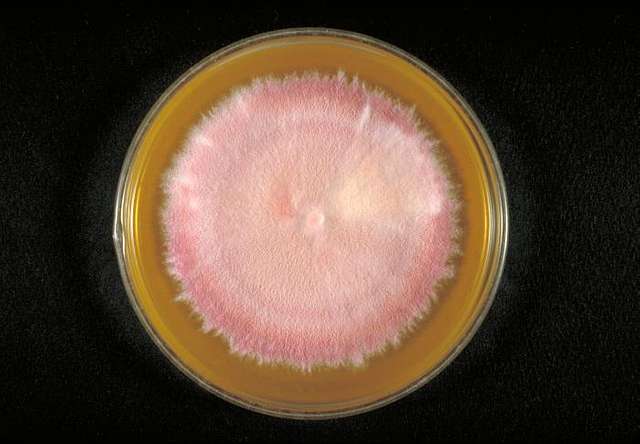New fungal strain that can destroy food toxin
Patulin (C7H6O4) is a mycotoxin synthesized by several fungal strains. It is a secondary metabolite toxic to mammals, human and plants. Patulin is found in damaged fruits like grapes, apple and pears and on many occasions, it also contaminates fruit juices, jams and sauces. Recently, researchers from Japan (Mita et al., 2023) have identified a new filamentous fungal strain ‘Acremonium sp. TUS-MM1’ which can detoxify patulin. Inside cells, Acremonium sp. TUS-MM1 can convert patulin into desoxypatulinic acid, which is very less toxic and outside the cells, TUS-MM1 produces a highly reactive compound that breaks patulin into several molecules which are less-toxic. The findings of this study will be beneficial in controlling patulin toxicity in food industry.
Sources:
- Tokyo University of Science. (2023, August 31). Newly discovered fungus helps destroy a harmful food toxin. Science Daily. Retrieved September 3, 2023 from sciencedaily.com/releases/2023/08/230831121739.htm
- Isolation and characterization of filamentous fungi capable of degrading the mycotoxin patulin. Microbiology Open, 2023; 12 (4), DOI:1002/mbo3.1373
Novel CRISPR-Cas9 technology to combat HIV
Scientists have designed a novel CRISPR-Cas9 gene editing system ‘EBT-001’ which is an adeno-associated virus 9 (AAV9)-based vector delivering SaCas9 and dual guide RNAs. The EBT-001 can edit simian immunodeficiency virus (SIV) genome which is related to HIV, the AIDS-causing agent in human. The EBT-001 was tested in rhesus macaques infected with SIV, an established model for HIV infection. EBT-001 injected intravenously could effectively delete the SIV genome from the tissues and cells of the experimental macaques. Moreover, the macaques showed no abnormal pathology as well as there were no off-target effects. Hence, the study showed that EBT-001 is safe and efficient in editing proviral DNA which could be a potential therapeutic approach against HIV in humans.
Sources:
- Preclinical safety and biodistribution of CRISPR targeting SIV in non-human primates. Gene Therapy, 2023; DOI:1038/s41434-023-00410-4
- Temple University Health System. (2023, August 17). Novel treatment based on gene editing safely and effectively removes HIV-like virus from genomes of non-human primates. ScienceDaily. Retrieved on September 3, 2023 from sciencedaily.com/releases/2023/08/230817164016.htm
Human can live with pig kidney for a month
Surgeons and scientists from NYU Langone Health / NYU Grossman School of Medicine have successfully performed xenotransplantation of pig kidney in human body which was functional for 32 days. In this experiment, the source of the kidney was a genetically engineered pig. To bypass hyperacute rejection, i.e., to avoid rapid antibody-mediated rejection of pig organs by humans, the alpha-gal gene was knocked-out from the donor pig. Moreover, the pig’s thymus gland was put underneath the outer layer of the kidney to stave off novel, delayed immune responses. The xenotransplantation was performed in a 57-year-old male declared dead based on neurologic criteria; however, on ventilator support, the patient was maintained with a beating heart. After transplantation, the kidney produced urine immediately, creatinine level was optimum in the blood and weekly biopsies showed no signs of rejection. This successful xenotransplantation proved that thousands of human lives could be saved in future where there is organ failure or scarcity of human donor by using pig organs.
Sources:
- NYU Langone Health / NYU Grossman School of Medicine. (2023, August 16). Pig kidney xenotransplantation performing optimally after 32 days in human body. ScienceDaily. Retrieved on September 3, 2023 from sciencedaily.com/releases/2023/08/230816114156.htm
Novel engineer bacteria to detect tumour DNA
Researchers from USA and Australia have engineered a special bacterium which has the capacity to detect the presence of tumour DNA in a live organism. The team has engineered Acinetobacter baylyi as a biosensor to detect donor DNA (KRAS gene sequence) from the genomes of colorectal cancer (CRC) cells, tumours and organoids because KRAS gene is mutated in many types of cancer. The sensor bacterium was programmed with CRISPR system to discriminate the mutant from the normal copies of the KRAS gene and could produce signal when there was presence of the mutant KRAS gene. The protocol was named as Cellular Assay for Targeted CRISPR-discriminated Horizontal gene transfer or CATCH. Finally, CATCH was tested in CRC mice model, and it showed promising results by detecting cancer specific cell-free DNA molecules.
Sources:
- Engineered bacteria detect tumor DNA. Science, 2023 DOI: 1126/science.adf3974
- University of California – San Diego. (2023, August 10). Researchers engineer bacteria that can detect tumor DNA: Advanced biosensor leverages CRISPR to identify colon cancer. ScienceDaily. Retrieved on September 3, 2023 from sciencedaily.com/releases/2023/08/230810140813.htm
First indigenous mRNA vaccine from India
India has developed its first mRNA vaccine ‘GEMCOVAC®-OM’ which is Omicron-specific booster vaccine for COVID-19. One of the biggest advantages of this vaccine is that it does not require ultra-cold chain unlike other mRNA vaccines as well as it can be administered intra-dermally using a needle-free injection device system. It was approved for Emergency Use Authorization (EUA) by the Drug Control General of India (DCGI). It was a combined effort of DBT, Govt. of India, Biotechnology Industry Research Assistance Council (BIRAC) and Gennova Biopharmaceuticals Ltd., India.
Source:




